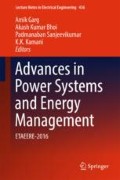Abstract
India focuses on many sectors out of which much of its growth in energy consumption is expected to occur in the countries outside the Organisation for Co-operation Economic and Development (OCED) known as non-OCED where demand will be drawn by strong, long-term economic growth and India fits into this particular category. In this research, the spinning mill is considered for optimizing the parameters regarding the energy management with the real-time data taken from a ring frame unit of spinning mill, analysis is done to find the feasible operating conditions with the aim of minimizing the energy cost and increasing the profitability of the sector, thereby suggesting for the spinning mill sector in India.
Access this chapter
Tax calculation will be finalised at checkout
Purchases are for personal use only
References
Nimon, W., Beghin, J.: Ecolabels and international trade in the textile and apparel market. Wesley Am. J. Agric. Econ. 81(5), 1078–1083 (1999). http://lib.dr.iastate.edu/card_workingpapers/228/
Kneller, R., Stevens, P.A.: Frontier technology and absorptive capacity evidence from OECD manufacturing industries. Oxford Bull. Econ. Stat. 68(1), 1–21 (2006). http://onlinelibrary.wiley.com/doi/10.1111/j.1468-0084.2006.00150.x/abstract
Jimenez-Rodriguez, R.: The impact of oil price shocks: evidence from the industries of six OECD countries. Energy Econ. 30(6), 3095–3108 (2008). www.sciencedirect.com/science/journal/01409883/30
Kumar, D., Singh, D.: Export competitiveness of indian textile industry. Abhinav Nat. Monthly Refereed J. Res. Commer. Manage. 4(2), 1–7 (2015). http://abhinavjournal.com/journal/index.php/ISSN-22771166/article/view/535
Tandon, N., Reddy, E.E.: A study on emerging trends in textile industry in India. Int. J. Adv. Res. Technol. 2(7), 267–277 (2013)
Singh, M.P., Lal, M.: Export performance and competitiveness of Indian textile industry. Int. J. Sci. Res. 2(11), 315–316 (2013). http://citeseerx.ist.psu.edu/viewdoc/download?doi=10.1.1.685.3177&rep=rep1&type=pdf
Sharma, M., Dhiman, R.: Determinants affecting indian textile exports. A Rev. Biz Bytes. 6(2), 195–201 (2015). http://cbsmohali.org/img/Determinants%20Affecting%20Indian%20Textile%20Exports%20A%20Review
Silber, S., Sloupensky, J., Dirnberger, P., Moravec, M., Amrhein, W., Reisinger, M.: High-speed drive for textile rotor spinning applications. IEEE Trans. Ind. Electron. 61(6), 2990–2997 (2014). http://ieeexplore.ieee.org/stamp/stamp.jsp?arnumber=6504511
Muthukumar, E., Nisha, K.G.: A study on the effect of material price fluctuations on the profitability of yarn industry in India with special reference to Precot Meridian Ltd. Res. J. Financ. Acc. 5(19), 134–144 (2014). www.iiste.org/Journals/index.php/RJFA/article/download/16853/17192
Gupta, N.: Analysis on the defects in yarn manufacturing process & its prevention in textile industry. Int. J. Eng. Inventions. 2(7), 45–67 (2013). http://www.ijeijournal.com/papers/v2i7/H02074567.pdf
Altas, S., Kadoğlu, H.: Comparison of conventional ring, mechanical compact and pneumatic compact yarn spinning systems. J. Eng. Fibers Fabr. 7(1), 162–170 (2012). http://www.jeffjournal.org/papers/Volume7/7.1.10.Altas.pdf
Koç, E., Kaplan, E.: An investigation on energy consumption in yarn production with special reference to ring spinning. Fibres Text. East. Eur. 15(4), 18–24 (2007). www.fibtex.lodz.pl/2007/4/18
Hasanbeigi, A., Hasanabadi, A., Abdorrazaghi, M.: Energy-efficiency technologies and comparing the energy intensity in the textile industry. In: Industry Reprint version of proceedings of the American Council for an Energy-Efficient Economy’s, pp. 26–29 (2011)
Hasanbeigi, A., Price, L.: A review of energy use and energy efficiency technologies for the textile industry. Renew. Sustain. Energy Rev. 16, 3648–3665 (2012). https://publications.lbl.gov/islandora/object/ir:158360/datastream/PDF
Shyjith, K., Ilangkumaran, M., Kumanan, S.: Multi‐criteria decision‐making approach to evaluate optimum maintenance strategy in textile industry. J. Qual. Maintenance Eng. 14(4), 375–386 (2008). www.emeraldinsight.com/doi/abs/10.1108/13552510810909975
Joseph, J., Vetrivel, M.A.: Impact of target costing and activity based costing on improving the profitability of spinning mills in Coimbatore. J. Contemp. Res. Manag. 7(2), 41–56 (2012). http://www.psgim.ac.in/journals/index.php/jcrm/article/download/226/215
Shakil, M., Ullah, M.R., Lutfi, M.: Process flow chart and factor analysis in production of a jute mills. J. Ind. Intell. Inf. 1(4), 247–254 (2013). www.jiii.org/uploadfile/2013/1118/20131118105220639
Khan, M.K.R., Hossain, M.M.: An experimental investigation of the effects of some process conditions on ring yarn breakage. IOSR J. Polym. Text. Eng. 2(2), 29–33 (2015). www.iosrjournals.org/iosr-jpte/papers/Vol2-issue2/D0222933
Author information
Authors and Affiliations
Corresponding author
Editor information
Editors and Affiliations
Appendix 1
Appendix 1
The additional energy cost (Rs.) at various speeds is calculated by subtracting the respective actual energy cost with the energy cost value of 16,000 rpm.
Example: Taking the energy cost of 18,000 rpm from Table 5, the additional energy cost is calculated as:
Similarly for the Additional energy consumed (units), Additional production (kg) and Additional profit (Rs.) are calculated for various speeds with the reference values of 16,000 rpm.
The profit per day is calculated as:
Rights and permissions
Copyright information
© 2018 Springer Nature Singapore Pte Ltd.
About this chapter
Cite this chapter
Helen Catherine, R.L., Soundarrajan, A., Louis, J.R. (2018). Cost Optimization of a Ring Frame Unit. In: Garg, A., Bhoi, A., Sanjeevikumar, P., Kamani, K. (eds) Advances in Power Systems and Energy Management. Lecture Notes in Electrical Engineering, vol 436. Springer, Singapore. https://doi.org/10.1007/978-981-10-4394-9_11
Download citation
DOI: https://doi.org/10.1007/978-981-10-4394-9_11
Published:
Publisher Name: Springer, Singapore
Print ISBN: 978-981-10-4393-2
Online ISBN: 978-981-10-4394-9
eBook Packages: EnergyEnergy (R0)

